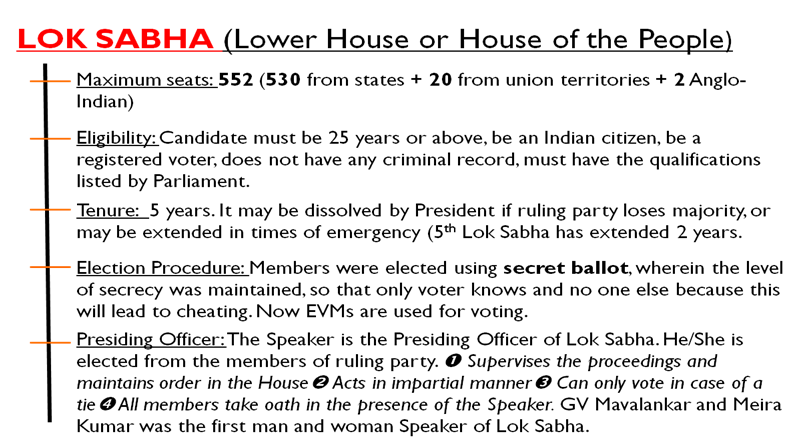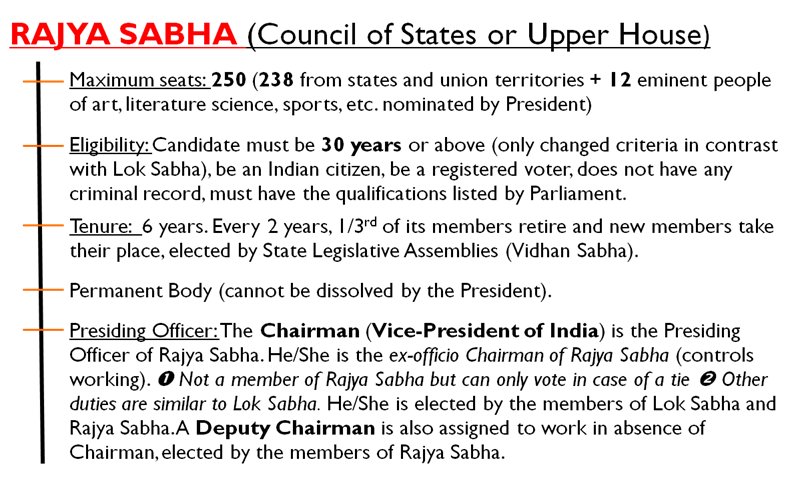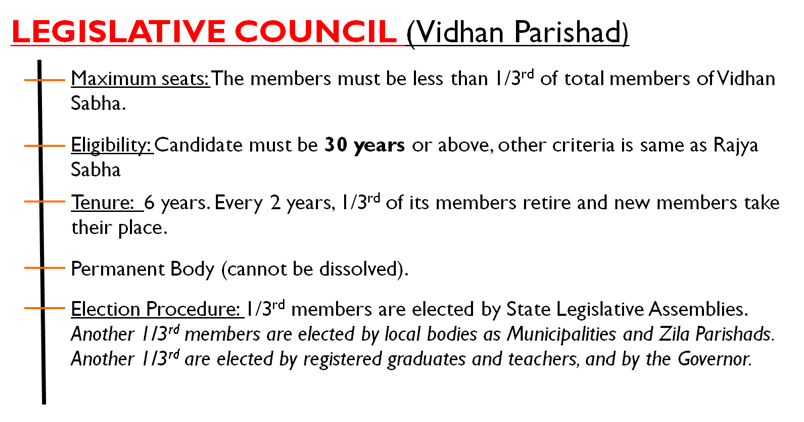Hello friends,
In India’s democracy, the State Legislature and Parliament are like important puzzle pieces. They help make rules and laws that affect many people. The State Legislature takes care of local matters (state affairs), while Parliament handles big national stuff. In this article, we’ll talk about what State Legislature and Parliament do and why they’re so important for our country.
PARLIAMENT
WHAT IS PARLIAMENT?
Parliament (Sansad)
It is a congregation (group of people, especially for a religious purpose) of elected representatives, and on behalf of the people, exercises political authority and makes laws. Union Legislature (Parliament) is the supreme law-making body in our country and symbolizes democracy. It consists of President (signatory head), Lok Sabha and Rajya Sabha.
Why do we need a Parliament?
It shows the idea of people participation in decision-making, where people are not the part of Parliament, but the elected members make decision of behalf of the people.
This involvement of people in decision-making shows the ‘Spirit of Democracy’.
Why should citizens decide the Parliament?
Because we require a people-centric government, and not a dictator to rule.
FUNCTIONS OF GOVERNMENT
THREE ORGANS/BRANCHES OF GOVERNMENT
Making laws is one of the most important functions of the government, and our duty is to follow those laws. The functions of government are carried out by:
- Legislature: makes laws (law-making organ).
- Executive: implements on these laws.
- Judiciary: makes sure the laws are being properly implemented in the society and finds resolution of disputes.
DIVISION OF RESPONSIBILITIES BETWEEN STATE & CENTRAL GOVERNMENTS
Subjects on which laws are made are divided between state and central governments in the form of lists.
- Union List: (union – central) subjects on which laws are made only by Parliament; applies on whole country; [for example: defence, finance, foreign affairs].
- State List: subjects on which laws are made only by State Legislative Assemblies (Vidhan Sabha); applies individually on each state; [for example: land reforms, agriculture, irrigation, police, healthcare, sanitation].
- Concurrent List: subjects on which laws are made by both Parliament and State Legislative Assemblies; applies on whole country; [for example: education, factories or industries, electricity, labour].
NOTE: When both Parliament and State Legislative Assembly make laws on the same subject and they disagree with each other, the law made by Parliament is accepted over State Legislative Assembly.
LOK SABHA
Lok Sabha is the Lower House or the House of the People. The other important details about Lok Sabha are provided in the image below.

ADDITIONAL INFORMATION ABOUT LOK SABHA
Every state has a fixed number of seats in Lok Sabha depending on state’s population. Each seat is called a constituency (1 seat = 1 constituency). Each constituency is the protective territorial area represented by one Member of Parliament (called MP).
RAJYA SABHA

NOTE: The President has the only function in Parliament to sign the bills to convert bills to laws (discussed later in the chapter).
Also read:
- HISTORY OF COMPUTERS | KnockLedge
- File Management | Organization of Data
- State legislative assemblies of India
POWERS & FUNCTIONS OF PARLIAMENT
LAW-MAKING FUNCTION
The Parliament can make amendments in the Constitution (introduce new laws and change the old ones). What is a bill? Bill is a proposed law. To make any amendment (adding, removing or changing laws) in the Constitution, a bill must be passed by any of the Houses. This bill goes through many steps and finally reaches the President for the approval. Once the President’s consent is received, the bill becomes a law. Therefore, bill is a proposed law. There are three types of bills:
HOW A BILL BECOMES A LAW?
Step 1: First reading of bill (introduction of bill in House). The person who introduced it explains the importance and purpose of the bill.
Step 2: Copies of bill are distributed to all members. Second reading takes place (takes time).
Step 3: Detailed discussions and arguments are put up like a debate. The person who is in favour of bill tells his reason, and the person who argues tells his reason.
Step 4: The new bill forms after changes. If required, further changes take place when this bill is sent to a joint committee (selected members of both Houses) or a second committee (selected members of the House who favour the bill).
Step 5: After all changes, third reading happens.
Step 6: Finally, discussion of bill takes place and the bill put to vote. If majority, the bill goes to another House for same procedures above. If minority, bill can dissolve in the House itself.
Step 7: After majority, the other House either passes the bill to the President or sends the bill back to the House with the suggestions.
Step 8: Once the bill reaches the President after all these procedures, as and when the President signs the bill, it becomes a law.
SELECTING A NATIONAL GOVERNMENT
- When a political party (is an organization that coordinates candidates to compete in elections) gets maximum seats (absolute majority – about 3/4th of the seats in Parliament), the President invites them to form the government.
- The party can run the government until it has majority in the house.
- Coalition government: it is formation of a government when there is no clear or proved majority for any party or in times of national crisis. Therefore, the bigger party gets help from smaller parties (work together temporarily to form the government) by giving high posts to the MPs of smaller parties.
ELECTORAL OR ELECTIVE FUNCTIONS
- Parliament elects the President (by Electoral College) and Vice-President of India.
CONTROL OVER THE GOVERNMENT
- A government comes to existence only when the Parliament approves it. Government is answerable to Lok Sabha. MPs have the right to ask questions about the actions taken by government.
- If Lok Sabha passes a vote of no-confidence (passed by opposition to ruling party council of members and PM) against the Council of Ministers, then it has to resign from the office.
- Parliament has the right to move an adjournment motion (this motion is to discuss and focus on any matter of public importance that needs immediate attention from the government).
- Parliament can always ask questions from the ministers and discuss about government policies, to keep a check on the ministers and their departments.
JUDICIAL POWERS
- Parliament has the power to remove the President, judges of Supreme Court and High Court and some other officials.
- And they do so by a process called impeachment.
- Parliament can practise impeachment in case they find these people violating the Constitution, or misusing the status, or indulging in any sort of corruption.
FINANCIAL CONTROL
- Parliament is the custodian (guardian) of the national purse. This means, it has the power of all the economy in India.
- Every year, the Finance Minister presents the budgets (estimate of income and expenditure of a year) in the Parliament.
- Parliament has the power to vote a cut, reject or amend in the budget.
DIFFERENCE BETWEEN LOK SABHA AND RAJYA SABHA
In the following table, we have mentioned the major differences between the two Houses.
RELATION BETWEEN THE TWO HOUSES | |
| LOK SABHA | RAJYA SABHA |
| The introduction of money bill only here (all work related to money bill is only here) | No authority to money bills. It only has advisory powers |
| The Council of Ministers is only answerable to Lok Sabha | No responsibility |
| Introduction of confidence and no-confidence motions | No role in this case |
| It plays no role in setting up of the All India Services | Rajya Sabha only creates All India Services |
STATE LEGISLATURE
State Legislature: It is the Parliament at State level, not at the union or central level. Nevertheless, the functions and other criteria are same as that of Lok Sabha and Rajya Sabha. The State Legislature consists – Legislative Assembly (Lower House or Vidhan Sabha; Corresponds to Lok Sabha) & Legislative Council (Upper House or Vidhan Parishad; Corresponds to Rajya Sabha).
LEGISLATIVE ASSEMBLY (VIDHAN SABHA)

LEGISLATIVE COUNCIL (VIDHAN PARISHAD)

UNICAMERAL AND BICAMERAL LEGISLATURE
Unicameral Legislature: The states that have only one Legislative Assembly.
Bicameral Legislature: The states that have Legislative Assembly and Legislative Council both, have bicameral legislature. There are only six states namely Andhra Pradesh, Uttar Pradesh, Bihar, Telangana, Maharashtra, and Karnataka, that have bicameral legislature.
NOTE: Two union territories, Delhi NCR and Puducherry, have legislative assemblies.
FUNCTIONS OF STATE LEGISLATURE
- Make laws suitable to the needs of state (based on state list and concurrent list).
- Financial control over states
- Control over the government
- Participation in the election of President (Electoral College)
NOTE: Part XI of the Indian Constitution lists the powers of the centre and states in India. It has three lists – (Union, State, Concurrent) List.
In conclusion, the State Legislature and Parliament play crucial roles in our democratic system. They make laws and represent the people’s voices. Understanding their functions is vital for every citizen. Your awareness is key to a strong democracy.
Thank you, dear readers for visiting our website theknockledge.com, and reading our article. Your support and interest mean a lot to us. I appreciate your time and hope you find value in my other articles too. Keep coming back for more knowledge and insights!

